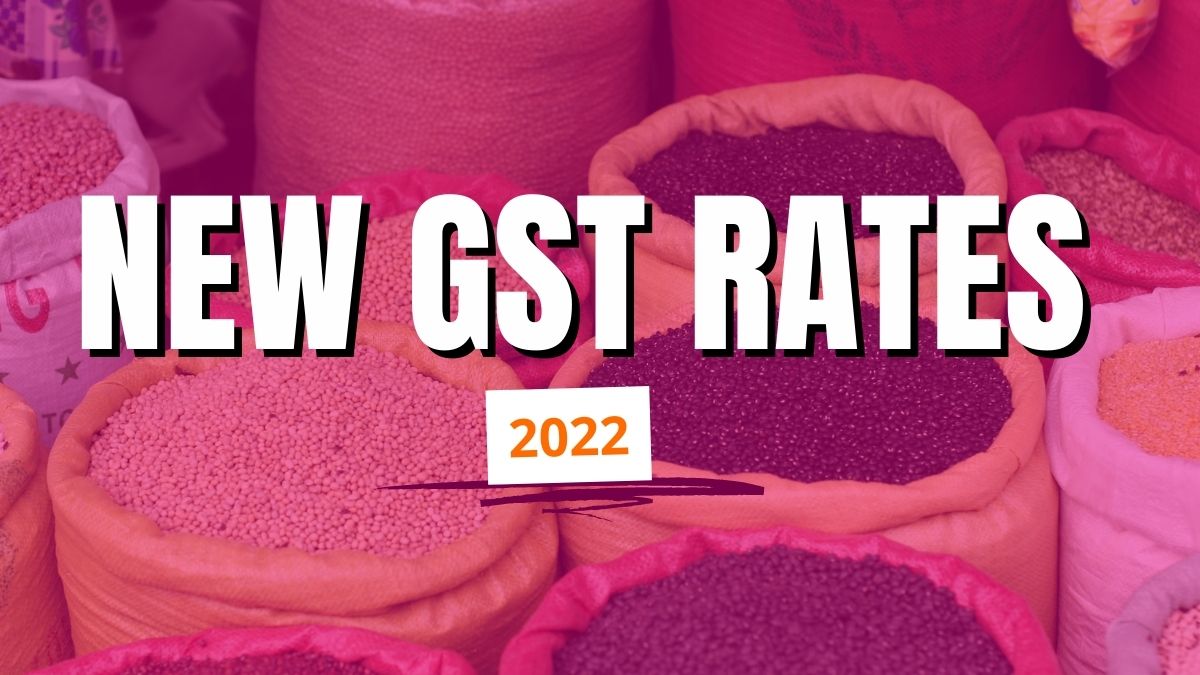New GST Rates 2023, Effective from 18th July

The centre in its public notification issued new changes to the existing GST rate structure. The new GST rates were announced by the GST council after its 47th meeting held last month in Chandigarh. Headed by the residing finance minister Nirmala Sitharaman, the GST council in its two-day meet decided to bring several changes to the existing rate structure including entry of some necessary food items earlier out of the purview of GST.
The new GST rates come into effect from July 18th 2022. Households and business firms are yet to discover its impact on the consumption and revenue trend after such a move by the centre. This article presents a theoretical summary of all the revised and new changes to the GST rate structure and some primary GST literature essential to access the new GST rate structure.

After almost five years since coming into effect, the GST regime has undergone multiple changes. These new GST rate changes are headed by the GST council which is meant to “make recommendations to the Union and the states on important issues related to GST, like the goods and services that may be subjected or exempted from GST, model GST Laws”. The various rate slabs of the GST structure is also decided by the GST council itself. In its 47th meeting on June 28th 2022, the GST council took some crucial matters into consideration such as the GST compensation to states and the imposition of taxes on some currently-exempt goods and services.
This move to include new GST rates in the ongoing regime witnessed significant outrage by the opposition, as a result of which the Lok Sabha proceedings for Tuesday were adjourned due to protest over price rise and the new GST rates. A significant blowback came for including necessary food items into the GST structure under the 5 % tax slab.
Below is the list of items that fall under the various tax slabs after a change in taxation following the new GST rates. While many necessary things are believed to get costlier, others experienced a fall against the previous price.
- Five per cent: Packed foods — milk, curd and paneer, Unpacked foods — rice and wheat when packed and bank fee for issuing cheques, Dried leguminous vegetables, Makhana, Wheat or meslin flour, Jaggery, Puffed rice, Organic food, Manure and compost, Ostomy appliances and transport of goods and passengers by ropeways (after the new GST rates), Electric vehicles, whether or not fitted with a battery pack.
- Twelve per cent: Hotels charging Rs 1,000 or less per day for stay, Solar water heaters (after the new GST rates), Finished goods like leather products, Maps and charts, including atlases, Renting of the truck, goods carriage where the cost of fuel is included (after the new GST rates).
- Eighteen per cent: Printing, Writing and drawing ink, LED lamps, Drawing instruments, Tetra packets, Services such as work contracts for roads, bridges, railways, metro, effluent treatment plants and crematoriums.
Also read about: How to Improve CIBIL Score Immediately? Guaranteed
The Central Board of Indirect Taxes (CBIC) also clarified the new GST rules
- It stated that all pre-packaged items with a quantity up to 25 kg would attract the 5 % GST rate and things above 25 kilograms pre-packaged in a single packet will be exempt from GST. The 5 % GST will also be levied on non-ICU hospital rooms with room rent above Rs 5,000 per day.
- Under the 12 % tax slab, hotel rooms with tariffs of up to Rs 1,000/day, maps and charts, including atlases, will get expensive after the new GST rates.
Items that saw a rise from the previous tax slab
- Printing, writing or drawing ink, knives with cutting blades, paper knives, forks, spoons, ladles and pencil sharpeners, LED lights and lamps, drawing and marking out instruments will now be taxed under the 18 % rate from the previous 12 % tax slab after the new GST rates.
- After the new GST rates, leather goods earlier taxed at 5 % will now follow the 12 % tax bracket.
- Solar heaters too are likely to get costlier after a slab increase from 5 % to 12 % after the new GST rates.
- Services such as the work contracts for roads, bridges, railways, metro, effluent treatment plants and crematoriums will also fall under the 18 % tax slab from the previous 12 % GST rate after the new GST rates.
However some goods are even more likely to get cheaper following the new GST rates. GST on ostomy appliances and on the transport of goods and passengers by ropeways which was under the 12 % rate of taxation gets cheaper after the new GST rates to experience a 5 % rate of taxation. Electric vehicles, whether or not fitted with a battery pack are now eligible to be taxed at a lower of 5 % from July 18th 2022 after the new GST rates. A 12 % tax rate will be charged as against the previous 18 % tax rate on renting trucks and goods carriages where the cost of fuel is included.
Transportation of passengers by air to and from northeastern states and Bagdogra town will attract a GST exemption restricted to economy class only as per news outlets after the new GST rates. Services offered by regulatory bodies such as the RBI, IRDA and SEBI will be taxed at 18 % which would also include the service of renting of a residential dwelling to business entities.
Besides this a 12 % GST will be levied on Biomedical waste treatment facilities and individuals from sports, art and cultural background will now be able to claim GST exemptions for training or coaching in recreational activities.
Amidst the announcement of these reformed measures after the rolling of the new GST rates, the finance minister assured that all the decisions had been taken in the presence of GST council representatives from the different states and there was less cause for worry regarding the same.
Final Words
There is a complete detail of the new GST tax rates for 2022. Everybody must be aware of the tax rate structure and how it will impact their spending and living criteria. Make the decision wisely following the taxation structure of 2022.
